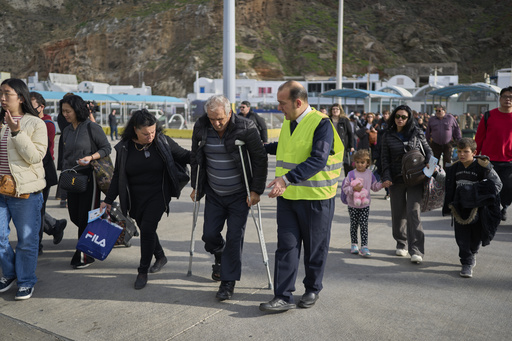ATHENS, Greece — Santorini, a well-known volcanic island in Greece, is currently experiencing a series of earthquakes, leading authorities to deploy rescue teams equipped with tents, a sniffer dog, and drones. As a precautionary measure, schools have been closed on four nearby islands.
Recently, scientists detected increased volcanic activity within the caldera of Santorini. However, they clarified that the ongoing seismic events are not directly linked to this recent activity.
Residents have been advised to avoid large indoor assemblies, verify escape routes, stay away from cliffs, and drain swimming pools to mitigate potential structural damage during a significant earthquake. Greece is situated in a seismically active region, making earthquakes a common occurrence. While most do not result in harm or damage, there have been occasions of severe earthquakes in the past.
As one of Greece’s top tourist destinations, Santorini has a crescent shape created by a substantial volcanic eruption in ancient times. Millions of tourists flock to the island annually to admire its picturesque landscape filled with white houses and blue-domed churches perched on the caldera’s edge.
Here’s an overview of the current situation:
What’s happening right now?
Since Saturday, numerous earthquakes with magnitudes ranging from 3 to 4.9 have been recorded between Santorini and the nearby island of Amorgos. Although Greece often experiences earthquakes, the current pattern of frequent and intense seismic activity without the occurrence of a major prior quake is unusual, according to seismologists.
The fault line responsible for these quakes extends approximately 120 kilometers (75 miles), but only a segment between Santorini and Amorgos has been affected thus far. Fortunately, the epicenters are located beneath the seabed, which is less likely to cause significant destruction compared to quakes centered on land. However, authorities are still cautious, as a substantial quake could trigger a tsunami, prompting them to advise residents to steer clear of coastal regions and move inland during strong tremors.
Currently, no major injuries or significant damage have been reported, although there have been a few minor rock slides.
Could these earthquakes lead to a volcanic eruption?
While it is theoretically possible, experts generally believe that an eruption is unlikely. “All scientists are in agreement that this scenario is highly improbable,” stated Costas Papazachos, a professor specializing in applied geophysics and seismology.
Santorini is part of the Hellenic Volcanic Arc, which traverses from Southern Greece’s Peloponnese to the Cycladic islands. This region comprises two notable volcanoes: Nea Kameni, an islet within the caldera, and Kolumbo, a submarine volcano located approximately 8 kilometers (5 miles) northeast of Santorini. The Greek Climate Crisis and Civil Protection Ministry reported last week that sensors detected “mild seismic-volcanic activity” inside the caldera, similar to activity in 2011, which lasted for several months without any issues.
Scientists maintain that the recent earthquakes are not connected to the volcanic activity.
What are the concerns of officials?
Authorities are working to ascertain whether these numerous quakes are foreshocks—smaller seismic events preceding a significant earthquake—or if they belong to an earthquake swarm consisting of smaller tremors that might persist for weeks or months. “There’s no straightforward technology or method currently available to predict the future behavior of these quakes,” Papazachos elaborated.
Seismologist Gerasimos Papadopoulos acknowledged that “the prospect remains” that the quakes, which started on January 24 and intensified recently, could be succeeded by a more powerful tremor.
Many of Santorini’s primary villages are situated on the edge of the volcano’s caldera, contributing to the island’s striking aesthetic appeal while also raising safety concerns in the event of a dramatic earthquake. The steep cliffs in some areas may increase the risk of rock slides.
What measures are being implemented?
In response to the situation, rescuers equipped with a sniffer dog and drones have been sent to Santorini, where they have established a temporary base in a basketball court adjacent to the island’s main hospital. Alerts have been sent to mobile phones instructing residents to keep clear of areas prone to rock slides and restricting access to certain coastal zones.
Officials have requested that residents and hotels drain swimming pools, as water movement during significant tremors could destabilize structures. Individuals are also urged to avoid old buildings and familiarize themselves with escape routes in heavily populated areas.
Schools on Santorini, as well as in the nearby islands of Anafi, Amorgos, and Ios, will remain closed throughout the week, with other adjacent islands also shutting down schools from Tuesday onwards.
What’s the historical context?
The most significant earthquake in Greece’s last century occurred in this region—a 7.7-magnitude temblor known as the Amorgos earthquake that took place in 1956, resulting in a tsunami approximately 20 meters (65 feet) high, inflicting extensive damage in Amorgos and Santorini, with fatalities exceeding 50.
Additionally, Santorini is the site of one of history’s most massive volcanic eruptions, recognized as the Minoan eruption, which transpired around 1,600 B.C. and led to the destruction of much of what was once a round island. This eruption is believed to have played a crucial role in the decline of the ancient Minoan society.
Despite still being an active volcano, its last significant eruption was recorded in 1950. “It’s important to understand that the Santorini volcano experiences substantial eruptions every 20,000 years,” expressed Efthymios Lekkas, a seismologist and head of the scientific monitoring committee for the Hellenic Volcanic Arc. “It has been 3,000 years since the last significant explosion, so we have a considerable interval ahead of us before facing another major eruption.”




